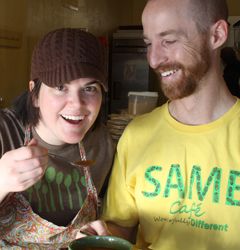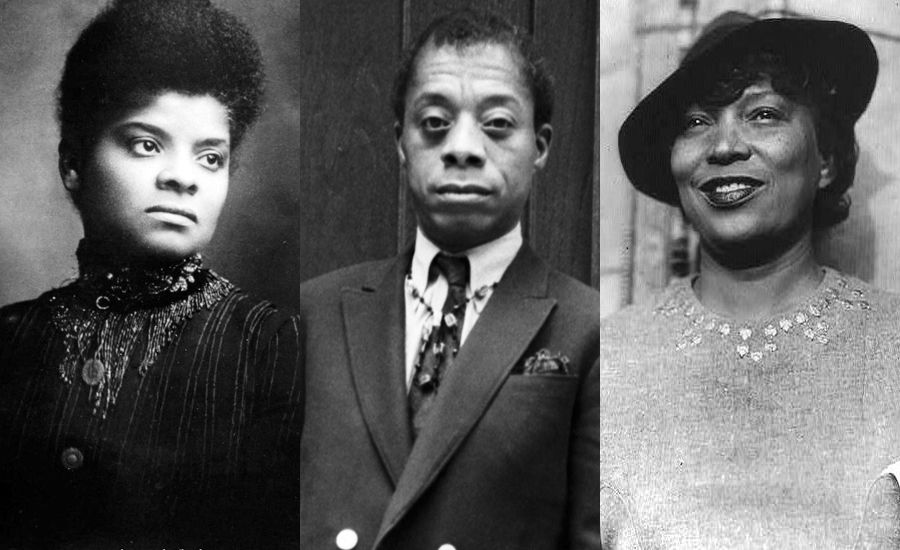Lunch hour is crazy at SAME Café, the 40-seat restaurant my husband, Brad, and I run in Denver.
Between cooking, serving, chatting with regulars and overseeing our staff, I hardly get a chance to eat. One day a woman in her fifties dressed in a business outfit strode in. “Hi, Libby,” she said.
I did a double take. Wow, she’s come a long way.
The first time she came to the café almost two years ago, she didn’t have money to pay for a meal. No problem. Like many customers, she volunteered to work. After a bowl of Brad’s white bean spinach soup and a slice of apple, pecan and bleu cheese pizza, she washed dishes and swept. Look at her now. I stole a glance at Brad, in the kitchen. Wasn’t this what we’d hoped for?
In 2003, on a flight home from Texas, we’d hatched this crazy dream. I was a teacher and Brad worked in IT. We’d both done a lot of volunteering at soup kitchens. It was something we felt called to do, feeding the poor. If only it weren’t so dispiriting at times.
“Remember the creamed peas we had to make?” I asked Brad. Big industrial cans of peas we mixed with flour—the end result looked like wallpaper paste. Probably tasted like it too. The guests didn’t seem any more inspired than we were. They sat at tables eating off of trays, nobody saying a word. “I wish we could start our own place.”
“Why don’t we?” Brad said. “Something more like a restaurant where people wouldn’t mind hanging out.”
We started jotting down ideas, me on a cocktail napkin, Brad in the margin of a magazine. “We’ll have a menu,” I said.
“Healthy food, fresh organic vegetables,” Brad added. He was the cook in our house, and a good one too.
“No cash register,” I said. “Just a donation box on the counter.”
It would be a charity, but we didn’t want our diners to think of it as a charity. “If a customer can’t pay,” Brad said, “he can help wash dishes or mop the floor.”
Brad signed up for culinary classes at night and I began looking for possible venues. Right away we hit hurdles. “There’s no such thing as a free lunch,” one potential landlord sniffed. “You seem like nice kids, but you’re crazy to think this will ever work.”
I met with brokers, contractors and suppliers, only to watch them walk away, shaking their heads. Was our idea that unrealistic? Lord, you’re going to have to clear the way here. We can’t do this on our own.
No bank would lend us the money to open a restaurant with no cash register. The only way we could get funds was to cash in thirty thousand dollars from our IRA—almost everything we had.
“Maybe we should just forget about this,” I said to Brad one night.
“Libby, this is something we believe in. We’ve gotta do it.”
Finally, a landlord agreed to lease us space on Colfax Street. We put flyers around the neighborhood, asked friends to spread the word, and held our breath.
Our first customer was a woman in her forties. She told me she was recently divorced and she and her two kids had no place of their own. “Could I have a salad?” she asked. I brought her a plate of greens with fresh fruit and nuts. Her eyes grew wide. “These are the first fresh vegetables I’ve had in four months,” she exclaimed. That alone made our struggles to open the café worth it.
Word traveled fast, thanks to stories in the papers and on TV. Soon we had more than 50 customers a day. “What do I owe you?” one patron asked.
“Whatever you think the meal’s worth,” I said, “whatever you can afford.” A few ate without paying or donating an hour of work. But most gave what they could, even if it was just a dollar.
At first Brad and I kept our day jobs. It was the only way to make ends meet. Then a funny thing happened. People from all walks of life started coming: lawyers, doctors, architects. They came for Brad’s cooking. But they also liked what our café stood for.
SAME is an acronym. It’s short for our credo: So All May Eat. Those with money gave, and then some. One of our customers left a check for five hundred dollars. Another bought one thousand dollars in gift certificates. Still another donated a truck so we could haul produce from organic suppliers. Eventually we were able to quit our day jobs and work full-time at the restaurant.
Our dream is coming true. We serve healthy food to people in need. We treat everyone with dignity. We hoped to develop a sense of community—the feeling that God had drawn us together, the comfortable and the poor, so that we might help one another. The woman in business attire was one of them.
Something was different about her that day. Something besides her outfit. She stopped at the counter and ordered greens with sun-dried tomatoes and goat cheese, and a ham and pineapple pizza.
“I have something to tell you,” she said. “The last time I was here, I started talking to a woman I’d met here before. She said, ‘There’s an opening in my office. Why don’t you come in and apply?’ I did—I got the job!” I knew what was different about her—confidence. Hope.
“I’m so happy for you,” I said.
She opened her purse. “I can pay now. How can I ever thank you?”
“You just did,” I said.
Try Brad’s Curried Carrot Soup!





